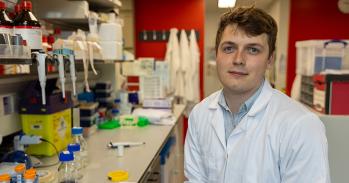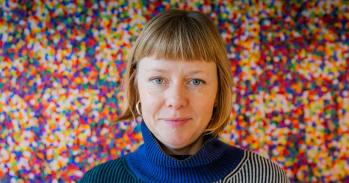
From organic chemist, through maker of rubber monsters, to conservator of fine art, Spike Bucklow describes his career path as "something of a drunkard's walk". But you could say that it has always been leading to the same end: the application of science for the benefit of art.
From organic chemist, through maker of rubber monsters, to conservator of fine art, Spike Bucklow describes his career path as "something of a drunkard's walk". But you could say that it has always been leading to the same end: the application of science for the benefit of art.
I look at the painting from the point of view of 21st-century science but I also think about the person who painted it hundreds of years ago.
Dr Spike Bucklow
Coming across an article in New Scientist 15 years ago that described the contribution science can make to art proved to be the catalyst for a career change that Spike Bucklow had unknowingly been waiting for. Until then, his career had taken him from the organic chemist’s bench, where he synthesised cockroach sex pheromones, to the film industry, where he designed and built prosthetic puppets, to artificial intelligence and technology transfer at Cambridge Consultants.
The New Scientist article led him to the Hamilton Kerr Institute – a place where science and art come together through the conservation of easel paintings and the analysis of artists’ materials and methods. In the 15 years since joining the Institute, a department of The Fitzwilliam Museum and linked to the University’s Faculty of Architecture and History of Art, his research has allowed him to combine his background as an organic chemist with his passion for how paintings have been created and how they can be preserved. Now a renowned expert on craquelure – the cracks that naturally form in oil paintings over time – he has also developed a solid grounding in the conservation of medieval art through working on the two oldest altarpieces in the UK: the Thornham Parva Retable and the Westminster Retable. His methods require an intriguing mix of state-of-the-art scanning electron microscopy, 3D imaging and analytical chemistry, together with an understanding of fine paintings, the creation of pigments and Aristotelian physics.
What would others be surprised to learn about you?
Working for Spitting Image and the film industry in the 1980s, my role was to take a combination of prosthetics and animatronics and create rubber monsters that flexed and moved – Jabba the Hut in Return of the Jedi, and Margaret Thatcher and Ronald Reagan in Spitting Image were all my models. People might also be surprised to know that my name really is Spike.
Who or what inspires you?
People who know what they’re doing and the evidence they leave. When I was a kid I went to Wookey Hole in Somerset and I saw someone making paper – he just scooped up this slurry and suddenly he’d made a sheet of paper. It was such an elegant, relaxed gesture and resulted in this perfect product. It’s the same with art: when I look at fine paintings, I see someone who knew what they were doing.
Have you ever had a Eureka moment?
About two decades before the film Pirates of the Caribbean appeared, I had an idea of how to connect computer-generated imagery with live action imagery and I envisaged it all in terms of a computer-generated parrot sitting on an actor’s shoulder. I was half-way through the patenting process when I discovered the conservation of paintings and I made the decision to become a conservator. So you could say that discovering the Hamilton Kerr Institute was my second Eureka moment.
What’s the best piece of advice you’ve ever been given?
When I joined the Institute I was a trained chemist who knew no art history. I went along to an art history lecture as part of re-training and the lecturer said to me: ‘Just because it’s written in a book doesn’t mean it’s true. Always go back to the source.’ Maybe I was a late developer with this, but it opened my eyes about how to think critically.
If you could wake up tomorrow with a new skill, what would it be?
A bareback horseman and world-class dressage champion.
What motivates you to go to work each day?
The opportunity to get really close to first-class works of art – the evidence of people who knew what they were doing – and to discover things about them that other people might not have noticed. I’m interested in the physical aspects of the painting today but also in the how and the why of its history, which is why I’m interested in alchemy and Aristotelian physics. I look at the painting from the point of view of 21st-century science but I also think about the person who painted it hundreds of years ago.
What will the future look like in 2050?
My job as a conservation scientist is to ensure that the paintings we work on will look good in 2050. In fact, our timescales are 50–100 years from now. We have theoretical models about how things will behave – how pigments age, how varnish yellows, and how the dynamic nature of the painting’s physical structure responds to light, humidity and the environment. But, although these are the timescales I aim for professionally, I know that all of the physical predictions that I make pre-suppose certain social and political structures, and my feeling is that these structures are a bit on the shaky side.
What’s your favourite research tool?
The University Library: it’s amazing what it contains. I’ve been looking for information on 17th-century alchemy in north Norfolk and they’ve got it!
This work is licensed under a Creative Commons Licence. If you use this content on your site please link back to this page.





